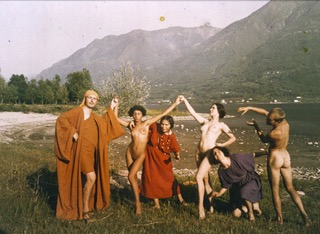History of the hill of utopia, between art, landscape and spirituality.
As part of the twinning signed between MAN and Monte Verità
for residences of Sardinian artists outside Moenia.
A journey in search of freedom, in a place where you can breathe true utopia
and dream of a different world.
At the dawn of the twentieth century, the Monte Verità colony located among the lush woods and rolling hills overlooking Lake Maggiore prophetically anticipated issues that are vital today,
between ecology of living and ecology of the soul.
Its founders were absolute pioneers of organic and eco-friendly living,
of vegetarian culture and body care in a natural sense.
An extraordinary current force has nourished this story and this journey ever since
to the origins of a regenerated relationship between man and creation.
The book Monte Verità. Back to nature is dedicated to the famous hill of utopia, to its founders and to the illustrious guests who saw in its spaces suspended in time a good retreat far from the drama of the wars and also from the ideological clash between capitalism and communism that was going through Europe. Cradle of an existence based on primordial rhythms, it became the laboratory of a new culture, a counter-culture born in response to bourgeois conformism and dominant thought, which attracted thinkers and anarchists, philosophers, theosophists, writers, artists and architects from every country. All together, welcomed into a land kissed by the sun, they adhered to the model of community life promoted by the German movement of “Lebensreform,” (life reform).
Edited by Sergio Risaliti, Nicoletta Mongini And Chiara Gatti the volume traces the centenary experience of Monte Verità which interweaves destinies of intellectuals and masters of the twentieth century. From the anarchist Bakunin to the Hungarian choreographer Rudolf von Laban, from the anarcho-communist theorist Pierre Kropotkin to the dadaist Hugo Ball, from the dancer Isadora Duncan to the great writer Hermann Hesse; and, again, from the Bauhaus architect Walter Gropius to the artists Hans Arp and Paul Klee, from Carl Gustav Jung to the curator Harald Szeemann who, fascinated by the history of the place, dedicated a traveling exhibition in Europe to it in 1978 with the emblematic title “Monte Truth. The breasts of truth”.
Germinated from the ribs of nineteenth-century romanticism and anarchism, the vocation of the settlers represents the first, true and larval historical reaction to the harmful conquests of modernity: industrialization and urbanization, individualism and exploitation, social gaps, repression and militarism. Against the backdrop of a chaotic metropolitan development, the sudden loss of the direct relationship with nature had produced that long literature of escape, made tragic and epic by the pages of Joseph Conrad and Jack London, by Life in the woods by Henry David Thoreau and the Nabis paintings. The so-called “wilderness” of the American tradition found a counterpart of extraordinary scope precisely in Monte Verità, a precursor of a contemporary sensitivity, of a critical reasoning anticipating the most recent tensions between globalized capitalism and nationalism.
Vegan diet, heliotherapy and nudism, gymnastics, dance and meditation were the daily practices of a community which then inspired, among many subjects, the well-known 2018 film by Mario Martone, Capri Revolution, testifying to a widespread interest still today towards the radical episodes of anarchist experiences as a social utopia, a pacifist and libertarian dream made possible by a “reform of life” which starts precisely from the regeneration of the body and spirit in a place, as will be said later late Ise Gropius, «where our forehead touches the sky».

